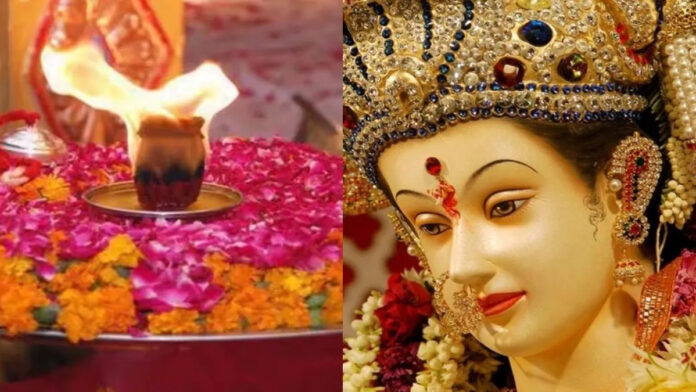From Ghatasthapana to kanika pujan and Jai Ambe Gauri Aarti to Durga Saptashati paath, Akhand Jyot is one of the most important elements of the Navratri puja vidhi (rituals).
Akhand Jyot is a traditional ritual during Navratri that is followed at home, temples, ashrams, and offices, where devotees take a sankalpa to keep the holy flame lit for a specific period. There are temples where Akhand Jyot has been continuously burning for many years.
Essence and Significance of Akhand Jyoti
“For an oil lamp to burn, the wick has to be partially immersed in the oil. If the wick is completely drowned in oil, it cannot bring light.” Gurudev shares, “Life is like the wick of the lamp, you have to be in the world and yet remain untouched by it. If you are drowned in the materialism of the world, you cannot bring joy and knowledge into your life. By being in the world, yet not drowning in the worldly aspect of it, we can be the light of joy and knowledge. Don’t forget that you are the light.”
Over some time, due to stress, worries and negativity, we tend to forget the essence of our being, our origin, our nature that is light. Hence, lighting the Akhand Jyot during festivals like Navratri reinforces this knowledge in us as we reconnect with ourselves.
“Light the lamp of wisdom and love in every heart and bring a radiant smile on every face,” Gurudev says while explaining the beauty of the practice of lighting a lamp, “Every human being has unique and good qualities. Every lamp that you light is symbolic of this. Some people have forbearance; some have love, strength, and generosity while others can unite people. The latent values in you are like a lamp, that must keep expressing itself. By lighting the lamp of wisdom in yourself and acquiring knowledge, you awaken all facets of your being.”
What is the practice of Akhand Jyot?
‘Akhand’ means uninterrupted or unextinguished and ‘jyot’ means flame. It is an oil or ghee lamp that lights continuously for 9–10 days during Navratri in reverence of the Mother Divine. The jyot represents pure knowledge, intellect, and creative talent. The flame signifies that we imbibe the qualities of compassion, unconditional love, contentment, and generosity from the Mother Divine or Devi Shakti.
We see with our eyes in the physical world when light enters the eyes and then gets reflected on the retina. These signals are then sent to the brain through the optic nerve to decode what we are watching. The wonder, however, is when we imagine objects in our minds or see them in our dreams. We see things without any physical light and interestingly, the brain’s visual cortex is stimulated even during dreams or imagination. This means that an unknown aspect of light illuminates our mind space (Chittakash).
Akhand Jyot in Gayatri Mantra
With reference to the Gayatri Mantra, Akhand Jyot represents the light that is eternally enlightening the three worlds, “…bhur bhuvah suvah…” – Bhootakash (the outer space), Chittakash (the space where emotions and thoughts originate) and Chidakash (the space of consciousness). Thus, Jyot is the representation of the Mother Divine, Gayatri. Know the significance of chanting Gayatri Mantra here.
Akhand Jyot in the Vedas
The significance of Akhand Jyot is incomplete without a Vedic insight. ‘Durga Suktam’ describes the Mother Divine as an eternal fire in which we can offer the three karmas and be free from their effects.
Agami (effects of our present and past actions yet to manifest),
Sanchita (total accumulated effects of past actions),
Prarabdha karma (manifestation of the impact of past actions in the present).
Listen to some of the sacred Devi chants (stotrams) this Navratri in the mellifluous voice of Smt. Bhanumathi Narasimhan.
How to light the Akhand Jyoti?
Use a long and thick baati (cotton wick) or make it of moli (a sacred red or orange cotton thread, believed to protect against negative elements and bad luck. It is also known as kalawa or raksha sutra).
Use brass, silver, or earthen lamp.
Fill the holy lamp with pure sesame, or mustard oil, or ghee (preferably made from desi cow’s milk).
Akhand Jyoti sthapana or establishment should be done on a clean chowki (a small table).
Draw an ashtadal (a pattern of an eight-petalled lotus) with gulal or raw rice on the chowki. It signifies purity, enlightenment, self-reconnect, prosperity, and harmony with the self and the cosmos.
At an auspicious time (refer to the vikram samvat) place the Akhand deep (lamp) in the center of the ashtadal. Place a ghee diya (lamp) on the right side of the Goddess while oil diya should be kept on the left side.
Perform pooja of the Akhand deep (lamp). Apply kumkum (roli) bindi or dot on the lamp symbolizing enthusiasm and offer rice (akshat), the symbol of prosperity.
Kalawa, dry rice and kumkum are an integral part of the Akhand Jyoti sthapana vidhi.
Light the diya reciting the following Sanskrit shloka,
Must dos of Akhand Jyot
Ensure that a sufficient length of wick is kept to help it burn until the end of the ninth day of the festival.
Keep a watch on the holy flame to ensure it is always lit.
Fill the Akhand jyot with ghee (or oil) at regular intervals. Ensure the inflamed end of the wick doesn’t get immersed in the fuel.
Always keep the Akhand jyot covered with a glass or metallic cover.
If you choose an earthen lamp, keep it soaked in water overnight to prevent it from absorbing excess oil or ghee while burning the holy flame.
To ensure the holy lamp keeps burning while you are adjusting its wick, light another lamp and then adjust the holy wick. Either put off the spare lamp by immersing its wick or let it burn itself out.
Let the holy flame extinguish itself after the nine days of Navratri are over.
It is advised to fast during the nine days of Navratri to keep the body and mind high on sattva which aids in connecting with the Self. Want to know how to fast during Navratri?
You can also meditate with Gurudev to connect deeper with the Self. Each day of Navratri is associated with a particular form of the Devi and when we meditate on her, the unique and benevolent qualities of the form get rekindled in us through meditation.
Gurudev takes us through simple yet effective meditations for each of the nine nights.
Dont’s of Akhand Jyot
Don’t let kids play around the Akhand Jyot to prevent it from blowing off.
Don’t pour solid ghee into the lamp; instead melt it. Solid ghee may put off the holy flame if not melted properly.
Don’t light the lamp near the toilet, or bathroom.
Don’t leave the Akhand Jyot burning at an unattended place.
Don’t use sunflower oil in the lamp.
Don’t displace the Akhand Jyot from its place for the 9 days of Navratri.
Keep a light and vegetarian diet.






























